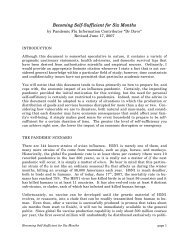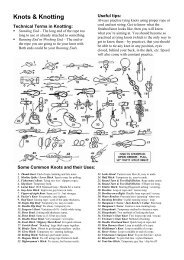You also want an ePaper? Increase the reach of your titles
YUMPU automatically turns print PDFs into web optimized ePapers that Google loves.
Pink Spore Print<br />
<strong>Edible</strong>: CLITOPILUS ABORTIVUS<br />
GENUS Clitopilus<br />
Clitopilus can be recognized by (i) the pale pink color of the<br />
spore print and (2) the fact that the gills are attached to the stem,<br />
sometimes running a short way down it. It grows on the ground,<br />
never on wood. Clitopilus abortivus (Figure 41) is the only common<br />
species, having been so named because of its frequently<br />
abortive shape, this malformation being due to the growth of a<br />
parasitic mold. Specimens not attacked by the mold have normal<br />
caps from 2 to 5 inches wide, convex in shape or with the margins<br />
raised slightly above the center; they usually pass from the<br />
former stage to the latter as they mature. The flesh is white and<br />
firm; it has a definite odor, difficult to describe but suggesting<br />
freshly ground grain and being at the same time slightly sharp.<br />
The gills run down the stem 1/8 inch or less, are close together,<br />
narrow, grayish when young and a pale, dusty rose when<br />
mature. The stems are from 3 to 4 inches long and 1/4 to 1/2<br />
inch in diameter, solid and fibrous. They grow either singly or<br />
in clumps, normal and diseased specimens side by side. Those infected<br />
with the mold are variously aborted, looking more like<br />
irregular puffballs than gilled fungi, although sometimes the mushroom<br />
stem and cap are evident. Both the normal and malformed<br />
specimens are good to eat, coming up in summer and fall near or<br />
under hardwood trees.<br />
GENUS Pluteus<br />
<strong>Edible</strong> but not choice: PLUTEUS CERVINUS<br />
Pluteus is distinguished by (i) pink spores., (2) gills that do<br />
not touch the stem, and (3) the fact that the stem and cap are<br />
separable. That is, if one takes the cap in one hand and grasps the<br />
70
















